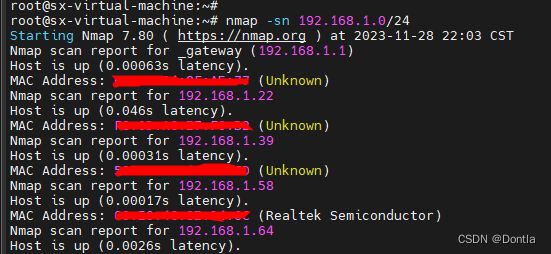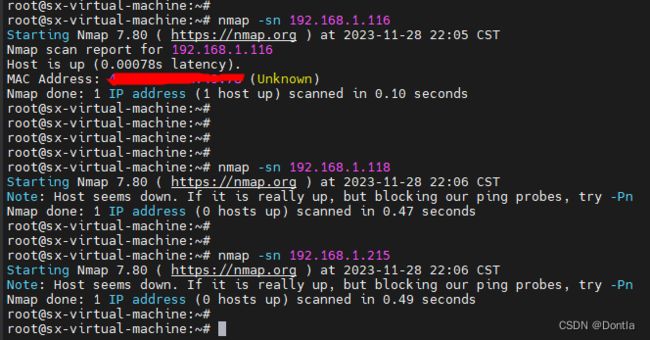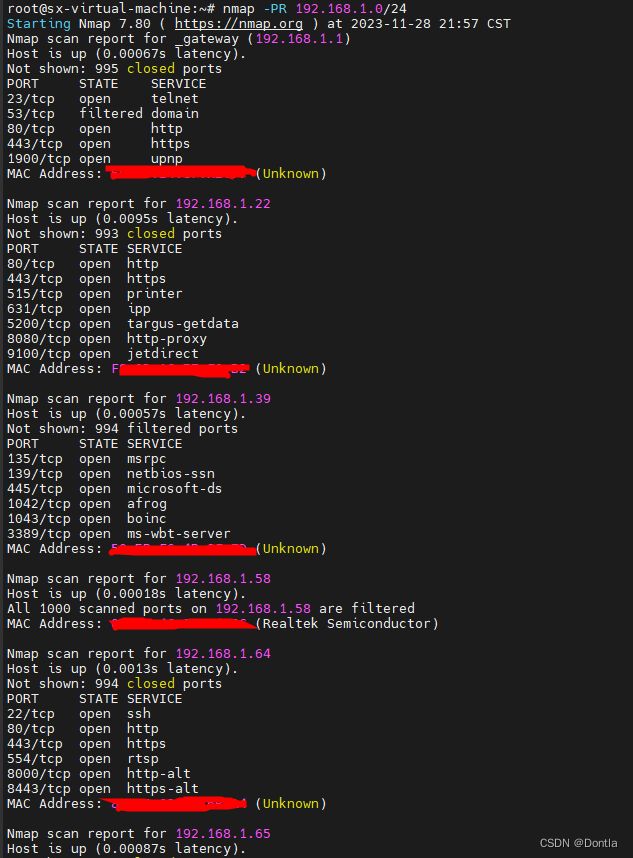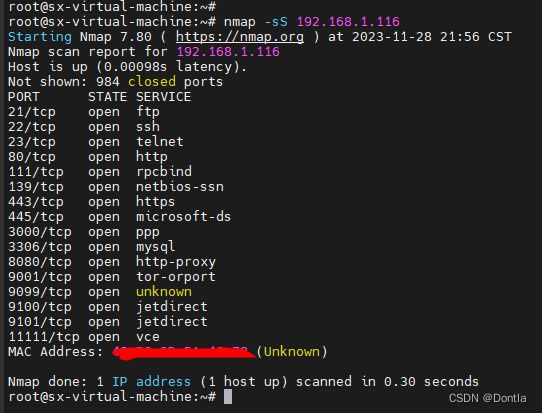Linux Nmap命令解析(Nmap指令)(功能:主机发现、ping扫描、arp扫描、端口扫描、服务版本检测、操作系统识别等)
文章目录
- Linux Nmap 命令解析
-
- 简介
- Nmap 的核心功能
-
- 主机发现
- 端口扫描
- 服务版本检测
- OS 指纹识别(操作系统指纹识别)
- 脚本扫描
- 安装 Nmap
- Nmap 命令结构
- Nmap 命令文档
-
- 英文
- 中文
- 主机发现
-
- Ping 扫描
- ARP 扫描
- 关于`nmap -PR`(ARP Ping Scan)和`nmap -Pn`(No Ping Scan)
-
- `-PR` ARP Ping Scan
- `-Pn` No Ping Scan
- 示例
- 总结
- 端口扫描
-
- 常见的端口扫描类型
- 示例:SYN 扫描
- 服务版本检测
- OS 指纹识别
- 使用 Nmap 脚本引擎 (NSE)
- 输出和报告
-
- 文本输出
- XML 输出
- Grepable 输出
- 高级技术
-
- 防火墙绕过
- 时间和性能
- 脚本参数
- 安全性和合法性
- 结语
Linux Nmap 命令解析
简介
Nmap(Network Mapper)是一款开源的网络探测和安全审核工具。它设计用于快速扫描大型网络,但也适合对单个主机进行各种检查。Nmap 由 Gordon Lyon(又名 Fyodor)编写,并首次发布于 1997 年。
Nmap 的核心功能
主机发现
主机发现是确定哪些主机在网络上活跃并响应的过程。
端口扫描
端口扫描用于发现目标主机上开放的 TCP 和 UDP 端口。
服务版本检测
服务版本检测可以确定端口上运行的应用程序及其版本信息。
OS 指纹识别(操作系统指纹识别)
通过发送特定的数据包序列并分析响应,Nmap 能够推断出目标系统可能运行的操作系统。
操作系统指纹识别,具体参考:nmap os detection原理及golang实现
脚本扫描
Nmap 提供了一个强大的脚本引擎(NSE),可以使用特定的脚本来发现额外的网络信息,或者检测和利用漏洞。
安装 Nmap
Nmap 在大多数 Linux 发行版中都可以通过包管理器轻松安装:
# Debian/Ubuntu 系统:
sudo apt-get install nmap
# Red Hat/CentOS 系统:
sudo yum install nmap
# Fedora 系统:
sudo dnf install nmap
Nmap 命令结构
基本命令格式如下:
nmap [扫描类型...] [选项] {目标规范}
其中,“扫描类型”定义了将执行的扫描方法,“选项”可用于进一步定制扫描,而“目标规范”指定了要扫描的目标。
Nmap 命令文档
nmap -h
英文
Nmap 7.80 ( https://nmap.org )
Usage: nmap [Scan Type(s)] [Options] {target specification}
TARGET SPECIFICATION:
Can pass hostnames, IP addresses, networks, etc.
Ex: scanme.nmap.org, microsoft.com/24, 192.168.0.1; 10.0.0-255.1-254
-iL <inputfilename>: Input from list of hosts/networks
-iR <num hosts>: Choose random targets
--exclude <host1[,host2][,host3],...>: Exclude hosts/networks
--excludefile <exclude_file>: Exclude list from file
HOST DISCOVERY:
-sL: List Scan - simply list targets to scan
-sn: Ping Scan - disable port scan
-Pn: Treat all hosts as online -- skip host discovery
-PS/PA/PU/PY[portlist]: TCP SYN/ACK, UDP or SCTP discovery to given ports
-PE/PP/PM: ICMP echo, timestamp, and netmask request discovery probes
-PO[protocol list]: IP Protocol Ping
-n/-R: Never do DNS resolution/Always resolve [default: sometimes]
--dns-servers <serv1[,serv2],...>: Specify custom DNS servers
--system-dns: Use OS's DNS resolver
--traceroute: Trace hop path to each host
SCAN TECHNIQUES:
-sS/sT/sA/sW/sM: TCP SYN/Connect()/ACK/Window/Maimon scans
-sU: UDP Scan
-sN/sF/sX: TCP Null, FIN, and Xmas scans
--scanflags <flags>: Customize TCP scan flags
-sI <zombie host[:probeport]>: Idle scan
-sY/sZ: SCTP INIT/COOKIE-ECHO scans
-sO: IP protocol scan
-b <FTP relay host>: FTP bounce scan
PORT SPECIFICATION AND SCAN ORDER:
-p <port ranges>: Only scan specified ports
Ex: -p22; -p1-65535; -p U:53,111,137,T:21-25,80,139,8080,S:9
--exclude-ports <port ranges>: Exclude the specified ports from scanning
-F: Fast mode - Scan fewer ports than the default scan
-r: Scan ports consecutively - don't randomize
--top-ports <number>: Scan <number> most common ports
--port-ratio <ratio>: Scan ports more common than <ratio>
SERVICE/VERSION DETECTION:
-sV: Probe open ports to determine service/version info
--version-intensity <level>: Set from 0 (light) to 9 (try all probes)
--version-light: Limit to most likely probes (intensity 2)
--version-all: Try every single probe (intensity 9)
--version-trace: Show detailed version scan activity (for debugging)
SCRIPT SCAN:
-sC: equivalent to --script=default
--script=<Lua scripts>: <Lua scripts> is a comma separated list of
directories, script-files or script-categories
--script-args=<n1=v1,[n2=v2,...]>: provide arguments to scripts
--script-args-file=filename: provide NSE script args in a file
--script-trace: Show all data sent and received
--script-updatedb: Update the script database.
--script-help=<Lua scripts>: Show help about scripts.
<Lua scripts> is a comma-separated list of script-files or
script-categories.
OS DETECTION:
-O: Enable OS detection
--osscan-limit: Limit OS detection to promising targets
--osscan-guess: Guess OS more aggressively
TIMING AND PERFORMANCE:
Options which take <time> are in seconds, or append 'ms' (milliseconds),
's' (seconds), 'm' (minutes), or 'h' (hours) to the value (e.g. 30m).
-T<0-5>: Set timing template (higher is faster)
--min-hostgroup/max-hostgroup <size>: Parallel host scan group sizes
--min-parallelism/max-parallelism <numprobes>: Probe parallelization
--min-rtt-timeout/max-rtt-timeout/initial-rtt-timeout <time>: Specifies
probe round trip time.
--max-retries <tries>: Caps number of port scan probe retransmissions.
--host-timeout <time>: Give up on target after this long
--scan-delay/--max-scan-delay <time>: Adjust delay between probes
--min-rate <number>: Send packets no slower than <number> per second
--max-rate <number>: Send packets no faster than <number> per second
FIREWALL/IDS EVASION AND SPOOFING:
-f; --mtu <val>: fragment packets (optionally w/given MTU)
-D <decoy1,decoy2[,ME],...>: Cloak a scan with decoys
-S <IP_Address>: Spoof source address
-e <iface>: Use specified interface
-g/--source-port <portnum>: Use given port number
--proxies <url1,[url2],...>: Relay connections through HTTP/SOCKS4 proxies
--data <hex string>: Append a custom payload to sent packets
--data-string <string>: Append a custom ASCII string to sent packets
--data-length <num>: Append random data to sent packets
--ip-options <options>: Send packets with specified ip options
--ttl <val>: Set IP time-to-live field
--spoof-mac <mac address/prefix/vendor name>: Spoof your MAC address
--badsum: Send packets with a bogus TCP/UDP/SCTP checksum
OUTPUT:
-oN/-oX/-oS/-oG <file>: Output scan in normal, XML, s|<rIpt kIddi3,
and Grepable format, respectively, to the given filename.
-oA <basename>: Output in the three major formats at once
-v: Increase verbosity level (use -vv or more for greater effect)
-d: Increase debugging level (use -dd or more for greater effect)
--reason: Display the reason a port is in a particular state
--open: Only show open (or possibly open) ports
--packet-trace: Show all packets sent and received
--iflist: Print host interfaces and routes (for debugging)
--append-output: Append to rather than clobber specified output files
--resume <filename>: Resume an aborted scan
--stylesheet <path/URL>: XSL stylesheet to transform XML output to HTML
--webxml: Reference stylesheet from Nmap.Org for more portable XML
--no-stylesheet: Prevent associating of XSL stylesheet w/XML output
MISC:
-6: Enable IPv6 scanning
-A: Enable OS detection, version detection, script scanning, and traceroute
--datadir <dirname>: Specify custom Nmap data file location
--send-eth/--send-ip: Send using raw ethernet frames or IP packets
--privileged: Assume that the user is fully privileged
--unprivileged: Assume the user lacks raw socket privileges
-V: Print version number
-h: Print this help summary page.
EXAMPLES:
nmap -v -A scanme.nmap.org
nmap -v -sn 192.168.0.0/16 10.0.0.0/8
nmap -v -iR 10000 -Pn -p 80
SEE THE MAN PAGE (https://nmap.org/book/man.html) FOR MORE OPTIONS AND EXAMPLES
中文
Nmap 7.80 ( https://nmap.org )
用法:nmap [扫描类型] [选项] {目标指定}
目标指定:
可以传递主机名、IP地址、网络等。
例如:scanme.nmap.org, microsoft.com/24, 192.168.0.1; 10.0.0-255.1-254
-iL <输入文件名>:从主机/网络列表中输入
-iR <主机数>:随机选择目标
--exclude <主机1[,主机2][,主机3],...>:排除主机/网络
--excludefile <排除文件>:从文件中排除列表
主机发现:
-sL:列表扫描 - 仅列出要扫描的目标
-sn:Ping扫描 - 禁用端口扫描
-Pn:将所有主机视为在线 - 跳过主机发现
-PS/PA/PU/PY[portlist]:对给定端口进行TCP SYN/ACK, UDP或SCTP发现
-PE/PP/PM:ICMP回声请求,时间戳和网络掩码请求探测
-PO[协议列表]:IP协议Ping
-n/-R:从不进行DNS解析/总是解析[默认:有时]
--dns-servers <服务器1[,服务器2],...>:指定自定义DNS服务器
--system-dns:使用操作系统的DNS解析器
--traceroute:追踪到每个主机的跳点路径
扫描技术:
-sS/sT/sA/sW/sM:TCP SYN/Connect()/ACK/Window/Maimon扫描
-sU:UDP扫描
-sN/sF/sX:TCP Null, FIN, 和 Xmas扫描
--scanflags <标志>:自定义TCP扫描标志
-sI <僵尸主机[:探测端口]>:空闲扫描
-sY/sZ:SCTP INIT/COOKIE-ECHO扫描
-sO:IP协议扫描
-b <FTP中继主机>:FTP弹跳扫描
端口规范和扫描顺序:
-p <端口范围>:仅扫描指定端口
例如:-p22; -p1-65535; -p U:53,111,137,T:21-25,80,139,8080,S:9
--exclude-ports <端口范围>:从扫描中排除指定端口
-F:快速模式 - 扫描的端口少于默认扫描
-r:连续扫描端口 - 不随机化
--top-ports <数字>:扫描最常见的<数字>个端口
--port-ratio <比率>:扫描比<比率>更常见的端口
服务/版本检测:
-sV:探测开放端口以确定服务/版本信息
--version-intensity <级别>:从0(轻量)到9(尝试所有探针)设置
--version-light:限制最可能的探针(强度2)
--version-all:尝试每一个探针(强度9)
--version-trace:显示详细的版本扫描活动(用于调试)
脚本扫描:
-sC:相当于 --script=default
--script=<Lua脚本>:<Lua脚本>是一个以逗号分隔的目录、脚本文件或脚本类别列表
--script-args=<n1=v1,[n2=v2,...]>:向脚本提供参数
--script-args-file=filename:在文件中提供NSE脚本参数
--script-trace:显示发送和接收的所有数据
--script-updatedb:更新脚本数据库。
--script-help=<Lua脚本>:显示关于脚本的帮助。
<Lua脚本>是一个以逗号分隔的脚本文件或脚本类别列表。
操作系统检测:
-O:启用操作系统检测
--osscan-limit:将操作系统检测限制为有希望的目标
--osscan-guess:更积极地猜测操作系统
计时和性能:
接受<time>的选项单位是秒,或者在数值后面添加'ms'(毫秒)、's'(秒)、'm'(分钟)或'h'(小时),例如30m。
-T<0-5>:设置计时模板(数字越大速度越快)
--min-hostgroup/max-hostgroup <size>:并行主机扫描组的大小
--min-parallelism/max-parallelism <numprobes>:探针并行化
--min-rtt-timeout/max-rtt-timeout/initial-rtt-timeout <time>:指定探针往返时间。
--max-retries <tries>:限制端口扫描探针重传的次数。
--host-timeout <time>:在这段时间后放弃目标主机
--scan-delay/--max-scan-delay <time>:调整探针之间的延迟
--min-rate <number>:发送包的速度不低于每秒<number>个
--max-rate <number>:发送包的速度不高于每秒<number>个
防火墙/IDS规避与伪装:
-f; --mtu <val>:分片数据包(可选择给定MTU)
-D <decoy1,decoy2[,ME],...>:使用诱饵隐藏扫描
-S <IP_Address>:伪造源地址
-e <iface>:使用指定接口
-g/--source-port <portnum>:使用指定端口号
--proxies <url1,[url2],...>:通过HTTP/SOCKS4代理转发连接
--data <hex string>:向发送的数据包附加自定义有效载荷
--data-string <string>:向发送的数据包附加自定义ASCII字符串
--data-length <num>:向发送的数据包附加随机数据
--ip-options <options>:发送带有指定IP选项的数据包
--ttl <val>:设置IP生存时间字段
--spoof-mac <mac address/prefix/vendor name>:伪造您的MAC地址
--badsum:发送带有错误的TCP/UDP/SCTP校验和的数据包
输出:
-oN/-oX/-oS/-oG <file>:分别以普通、XML、s|<rIpt kIddi3、可搜索格式输出扫描结果到指定文件名。
-oA <basename>:同时以三种主要格式输出
-v:提高详细等级(使用-vv或更多获得更大效果)
-d:提高调试等级(使用-dd或更多获得更大效果)
--reason:显示端口处于特定状态的原因
--open:仅显示开放的(或可能开放的)端口
--packet-trace:显示所有发送和接收的数据包
--iflist:打印主机接口和路由(用于调试)
--append-output:附加到指定的输出文件而不是覆盖
--resume <filename>:恢复中断的扫描
--stylesheet <path/URL>:XSL样式表将XML输出转换为HTML
--webxml:引用Nmap.Org的样式表以获得更便携的XML
--no-stylesheet:阻止将XSL样式表与XML输出关联
杂项:
-6:启用IPv6扫描
-A:启用操作系统检测、版本检测、脚本扫描和路由追踪
--datadir <dirname>:指定自定义Nmap数据文件位置
--send-eth/--send-ip:使用原始以太网帧或IP数据包发送
--privileged:假设用户具有完全权限
--unprivileged:假设用户缺乏原始套接字权限
-V:打印版本号
-h:打印此帮助摘要页面。
示例:
nmap -v -A scanme.nmap.org
nmap -v -sn 192.168.0.0/16 10.0.0.0/8
nmap -v -iR 10000 -Pn -p 80
查看手册页(https://nmap.org/book/man.html)了解更多选项和示例
主机发现
Ping 扫描
Ping 扫描用于确定哪些主机正在响应 ICMP 请求,示例如下:
nmap -sn 192.168.1.0/24
这将对 192.168.1.x 的所有地址执行 Ping 扫描,其中 x 是从 0 到 255 的任意值。
也可以对单个地址扫描:
nmap -sn 192.168.1.116
ARP 扫描
局域网中,ARP(地址解析协议)扫描通常比标准 ICMP ping 更有效,命令如下:
nmap -PR 192.168.1.0/24
对单个地址扫描:
nmap -PR 192.168.1.116
关于nmap -PR(ARP Ping Scan)和nmap -Pn(No Ping Scan)
在Nmap中,-PR 和 -Pn 是两个不同的扫描选项,它们用于不同的场景:
-PR ARP Ping Scan
-PR 选项告诉Nmap使用ARP请求来确定本地网络上的主机是否活跃。这种方法非常适合局域网内部,因为ARP请求无法跨过路由器,所以它只对本地子网有效。当想确认本地网络(同一广播域)中某个IP地址是否被占用时,使用-PR是合适的。
如果尝试对一个响应ARP但是不响应ICMP的设备进行-PR扫描,且结果显示"Host seems down",可能是因为该设备设置了防火墙规则来忽略或阻止ARP请求,或者Nmap没有正确地发送或接收ARP回应。这种情况下,可能需要检查你的网络设置或该设备的安全配置。
-Pn No Ping Scan
-Pn 选项告诉Nmap跳过发现阶段,直接执行端口扫描等后续操作。它假定目标主机是活跃的,不会先检测主机是否在线。这个选项适用于目标主机可能屏蔽了所有类型的ping探针(包括ICMP、ARP、TCP和UDP)的情况。
当使用-Pn选项时,即使目标主机关闭了对ICMP、ARP等探针的响应,Nmap也会尝试连接目标主机的端口来判断其在线状态。这种方法适用于任何网络环境,包括本地网络和跨越路由器的远程网络。
示例
nmap -Pn 192.168.1.215
此命令将对IP地址192.168.1.215执行扫描,不管目标主机是否响应任何形式的探针。
总结
如果确定是在本地网络上,并且知道目标主机可能会响应ARP请求,则使用-PR是合理的。如果-PR报告说主机看起来已经关闭,而怀疑主机实际上是开着的并且可能只是屏蔽了ARP请求,那么你可以尝试使用-Pn来绕过主机发现阶段,直接进行端口扫描。这样,即使ARP发现失败,仍然有机会通过观察端口的响应来确定主机是否在线。
端口扫描
常见的端口扫描类型
-sT:TCP 连接扫描-sS:SYN 扫描-sU:UDP 扫描-sA:ACK 扫描-sN、-sF、-sX:NULL、FIN 和 Xmas 扫描-sP:不扫描端口
示例:SYN 扫描
SYN 扫描是最流行的扫描类型,因为它快速且在网络上的隐蔽性较高:
nmap -sS 192.168.1.1
这将对 IP 地址为 192.168.1.1 的主机执行 SYN 扫描。
服务版本检测
使用 -sV 参数启动服务版本检测:
nmap -sV 192.168.1.1
这会对目标主机进行端口扫描,并尝试确定每个开放端口上运行的服务及其版本。
OS 指纹识别
OS 指纹识别可以通过 -O 参数启动:
nmap -O 192.168.1.1
这将提供关于目标主机操作系统的猜测。
使用 Nmap 脚本引擎 (NSE)
Nmap 具有广泛的脚本库,可用于进行更复杂的网络探测。运行特定的脚本,可以使用 --script 参数:
nmap --script=http-title 192.168.1.1
这将运行 http-title 脚本,该脚本会抓取 HTTP 服务的标题。
输出和报告
Nmap 支持多种输出格式,包括普通文本、XML 和 grepable 格式。
文本输出
默认情况下,Nmap 以文本形式输出到控制台。
XML 输出
XML 输出可以被许多其他工具用于进一步处理,命令如下:
nmap -oX output.xml 192.168.1.1
Grepable 输出
Grepable 格式便于使用文本处理工具如 grep 进行搜索,命令如下:
nmap -oG output.grep 192.168.1.1
高级技术
防火墙绕过
某些 Nmap 扫描技术可用于绕过防火墙,例如碎片扫描(-f)或者自定义 MTU(--mtu)。
时间和性能
调整扫描速度与准确性之间的平衡,可以使用 -T 选项,它接受从 0(最慢)到 5(最快)的值。
脚本参数
向 NSE 脚本传递参数可以使用 --script-args 选项,这样可以定制脚本的行为。
安全性和合法性
使用 Nmap 进行扫描时,必须遵守当地法律和政策。未经授权扫描他人网络或设备可能违反法律。
结语
Nmap 是网络管理员和安全专家的重要工具。它的灵活性和强大功能使其成为评估网络安全状态的理想选择。正确使用 Nmap 可以帮助识别和缓解网络安全风险。







